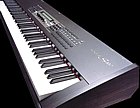| |
| BUNDLED
SOFTWARE |
 |
| |
The
supplied CD-ROM is a fundamental part of the S80 package, including
software support for both Windows95/98 and Macintosh (Power PC/MacOS8
or better) platforms. Installation procedure and applications change
depending on the computer operating system.
Installing the software on a PC/Win computer, 4 folders become available:
1) ACROREAD: it includes Acrobat Reader 4.0 to open the applications
PDF manuals.
2) MIDIDRV: it enables the S80 communication with PC when they have
been connected thru a serial cable.
3) CARD: it provides the Card filer function that enables the Bulk
Data Dump between PC and S80.
4) XGworks: it includes XGworks lite vers.3.0, a lighter version of
the Yamaha XGworks sequencer software. Besides the sequencer function,
a S80 AWM2 Internal Voices Editor is available. Moreover, dedicated
sound editors are also included to easily manage the synthesis generators
available after Plug-in boards installation (FM, AN, VL synthesis).
A Yamaha CS6X/CS6R dedicated Voice Editor is also provided. An Auto
Play funcion for Song playback repeat is available too.
Installing the software on Macintosh, the following 5 folders are
available:
1) ACROREAD: it provides Acrobat Reader 4.0 to open the applications
PDF manuals.
2) OMS: it includes both Open Music System 2.3.6 (enabling the Mac
OS MIDI functions) and OMS Yamaha Setup (OMS settings for a wide range
of Yamaha tone generators).
3) XG Editor: it allows to set the Voice and Effects parameters of
an XG tone generator.
4) VL Visual Editor: a convenient VL Synthesis Voice Editor that allows
an easy management and editing of the VL sounds available after VL
Plug-in board installation.
5) TOOLS: it provides the Card filer function and enables the Bulk
Data Dump between Mac and S80. It also includes two Voice Editor programs
for S80 and for Yamaha CS6X/CS6R.
Here below, you can find more details about the XGworks lite software
and the most interesting Voice Editors supplied with the CD-ROM.
|
| |
|
| XGworks
Lite by Yamaha (MacOS/Win) |
|
 |
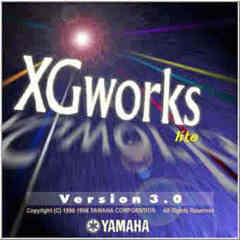 |
As
mentioned above, this software is a light version of the more complete
XGworks.
Basically, it provides the same operation, but some features (i.e.:
digital audio recording), functions and windows (Staff window, Staff
printing, Drum window, Auto Arranger, Guitar Arranger) are missed.
Anyway, in spite of this, it is a very useful tool.
The XGworks lite Plug-in applications, in fact, provide a convenient
graphic interface that allows an easy management of the synthesizer
parameters thru virtual knobs, sliders and switches.
The Internal Voices can be easily and quickly edited. The Plug-in
boards synthesis generators can be more intuitively programmed too.
The Menu bar of the sequencer main window gives access to the Voice
Editors. The sequencer provides advanced editing functions of MIDI
events and it can record up to 9.999 bars both in real and step time
(through mouse or MIDI keyboard). 100 tracks are available. The resolution
is 480 clock x quarter note.
The main window includes all the Song setup and editing functions
and gives access to other dedicated windows (Piano Roll, Event List,
Mixer, Master Track, etc.). The Songs can be saved in XG or SMF 0/1
formats. Data communication between computer and S80 can be made by
MIDI connection (Handshake mode) or thru the built-in synthesizer
To Host serial port. |
|
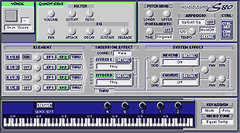 |
This
is the main window of the S80 Voice Editor.
The basic structure of the Voice is displayed in blocks. A Voice can
combine a maximum of 4 elements (sounds).
Once a Voice has been selected, this window allows:
- to switch on/off each Voice element.
- to edit the Voice common parameters (filter, EG, Pan and Volume)
- to switch on/off the Insertion and System Effects (Chorus and Reverb)
- to set the real time controls
- to switch on/off the Arpeggio function selecting the sequence type.
Some blocks of this window give access to other windows that provide
more specific parameters (i.e.: element wave type, effects settings,
etc.). Clicking on the virtual keyboard while editing parameters is
a convenient way to check the resulting sound.
A similar window is available for Drum sets. Here, drum sounds can
be directly assigned to the keyboard notes, also changing timbre and
volume. When S80 is switched off, all edited data are lost. So, it
is necessary to save the new Voices into the dedicated program library.
If the computer also uses Smart Media Card, the Voices can be saved
onto it. S80 will directly read the sounds, not needing MIDI Data
Bulk Dump. |
|
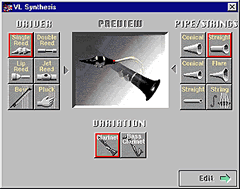 |
The
picture on the left shows the main window of the VL (Virtual Acoustic
Synthesis) Voice Editor, a really useful tool after PLG150-VLboard
installation.
The Virtual Acoustic Synthesis (also known as Physical modeling) reproduces
realistic winds, reeds and string instruments sounds thru mathematic
algorithms. The "instrument" defines the basic tone of the sound and
it consists of 2 elements: driver and resonator.
The driver simulates the sound generating vibration (i.e.: reed/mothpiece,
lip/mouthpiece or bow/string system). The resonator is the instrument
resonant element (i.e.: trumpet flare, pipe, violin body, etc.). Therefore,
first of all the VL Voice Editor main window allows to create the
"instrument", combining the driver and the pipe/strings elements on
the screen.
Depending on the created "instrument", two [or more] variations are
then available (on the left picture Clarinet and Bass Clarinet). Unusual
combinations are also possible (i.e: string drived by breath) generating
a wide range of unique sounds. Other windows are provided for timbral
(i.e.: brightness, thickness, color, distance, reverb) and amplitude
(EG attack and release) variations.
A specific window is dedicated to the BC3 optional breath control,
that allows the user to perform in a more expressive way. Sound timbre
and dynamics, in fact, can be controlled in real time by the breath
strenght. |
|
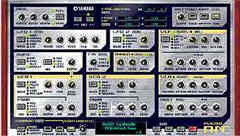 |
The
AN (Analog Physical Modeling) synthesis has been conceived to faithfully
reproduce the typical fat sound of the vintage analog synthesizers.
On the other hand, very particular sounds can also be created.
The picture on the left shows the AN Voice Editor main window. This
software allows to create and modify AN sounds after PLG150-AN board
installation.
The window reproduces the panel of a typical analog synthesizer and
provides virtual knobs and switches for an easy management of the
complex Physical Modeling Analog Synthesis. Some of the panel blocks
give access to sub-windows that allow graphical and numerical programming
of specific parameters. Waveforms are generated by 2 virtual VCO.
Both typical and unusual waveforms are available. Moreover, the PWM
can control not only the Pulse Wave, but also Saw and Mix (a combination
of Saw and Pulse) waves.
Once generated, the waveform is processed by virtual VCF and VCA for
timbral and amplitude shaping. VCF and VCA are both provided of an
individual EG control.
Oscillators Sync can be enabled as well as a type of FM Synthesis,
in which VCO 1 is always fixed as carrier, while VCO2, LFO and EG
can be alternatively selected as modulators.
The Mixer block includes Noise Generator together with Ring Modulator
and Feedback controls. In addition, a dedicated vintage-style window
provides a monophonic step sequencer too. The on-board additional
effects include a 3-band EQ and a guitar amplifier simulator with
distortion drive control.
This one is quite unusual in a vintage analog synthesizer panel, but
it is very useful to create more aggressive sounds. |
|
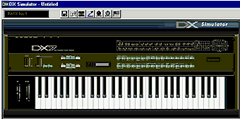 |
The
picture on the left is probably very familiar. It reproduces, in fact,
the firstborn Yamaha FM synthesizer: the DX-7. This is, also, the
main window of the FM Voices editing software that allows to manage
the PLG150-DX board.
Clicking on the synthesizer virtual panel, the LCD display and the
switches are magnified. At this point, the parameters can be selected
and set as usual like in a real DX-7.
Alternatively, it is possible to select another window (Edit List
View), that displays a chart including all the programming parameters.
In this case, sound edit can be performed by directly entering numeric
values.
At last, clicking the DX-7 virtual keyboard, it is possible to check
the results while editing sounds. |
| |
|
 |



